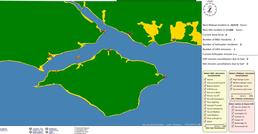Operational Simulation of the Solent Search-and-Rescue environment
- Started
- 14th June 2010
- Ended
- 31st December 2010
- Research Team
- Ben Schumann
- Investigators
- James Scanlan, Kenji Takeda, Hans Fangohr
As part of the DECODE-research project within the School of Engineering Sciences, this project models the Search-and-Rescue (SAR) environment of the Solent. DECODE is developing Unmanned Air Vehicles (UAVs) for SAR activities. Its requirements, design specifications and costs are investigated within this project. This is necessary in order to optimise the aircraft design before production and enable maximum cost benefit for possible SAR-customers such as the RNLI, MCA and MoD. The simulation is Agent-based and includes several key features:
-
detailed systems simulation (batteries, fuel, maintenance schedules, wear and tear, etc.)
-
flexible UAV-operations that can be changed during run-time (number of UAVs, location, etc.)
-
parametric UAV-characteristics to allow easy comparisons of different configurations
-
stochastic wind generator based on Solent-statistics
-
realistic operations for a helicopter, several lifeboats and the Solent coastguard (based on interviews and field visits)
-
realistic casualty generator based on RNLI and MCA statistics (including spatial distribution, severity distinctions and different mission types)
-
flexible, intuitive graphical interface with operational representation
Categories
Physical Systems and Engineering simulation: Flight simulation
Socio-technological System simulation: Human environment interaction, Operations Research, Transport, Value-driven design
Algorithms and computational methods: Agents
Software Engineering Tools: Eclipse, SVN
Programming languages and libraries: Java
Computational platforms: Mac OS X, Windows
Transdisciplinary tags: Complex Systems, Computer Science
